01-总论(张华林)20080808
第一章 总论(完整版)
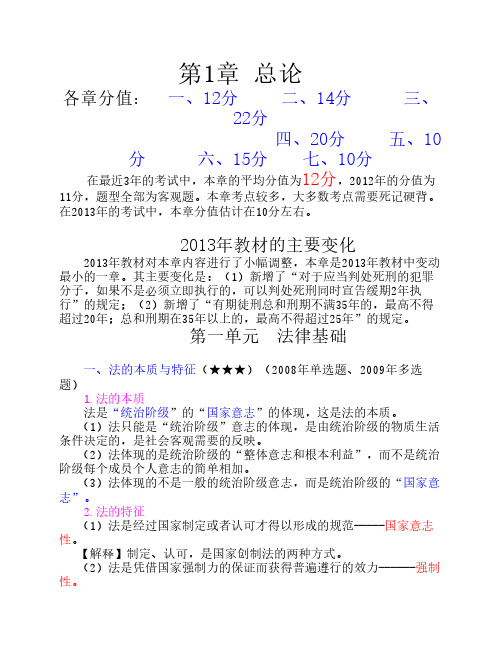
第1章 总论各章分值: 一、12分 二、14分 三、22分四、20分 五、10分 六、15分 七、10分在最近3年的考试中,本章的平均分值为12分,2012年的分值为11分,题型全部为客观题。
本章考点较多,大多数考点需要死记硬背。
在2013年的考试中,本章分值估计在10分左右。
2013年教材的主要变化2013年教材对本章内容进行了小幅调整,本章是2013年教材中变动最小的一章。
其主要变化是:(1)新增了“对于应当判处死刑的犯罪分子,如果不是必须立即执行的,可以判处死刑同时宣告缓期2年执行”的规定;(2)新增了“有期徒刑总和刑期不满35年的,最高不得超过20年;总和刑期在35年以上的,最高不得超过25年”的规定。
第一单元 法律基础一、法的本质与特征(★★★)(2008年单选题、2009年多选题)1.法的本质法是“统治阶级”的“国家意志”的体现,这是法的本质。
(1)法只能是“统治阶级”意志的体现,是由统治阶级的物质生活条件决定的,是社会客观需要的反映。
(2)法体现的是统治阶级的“整体意志和根本利益”,而不是统治阶级每个成员个人意志的简单相加。
(3)法体现的不是一般的统治阶级意志,而是统治阶级的“国家意志”。
2.法的特征(1)法是经过国家制定或者认可才得以形成的规范-----国家意志性。
【解释】制定、认可,是国家创制法的两种方式。
(2)法是凭借国家强制力的保证而获得普遍遵行的效力------强制性。
(3)法是确定人们在社会关系中的权利和义务的行为规范------利导性(利益导向性)。
(4)法是明确而普遍适用的规范------规范性。
【解释】法具有普遍适用性,凡是在国家权力管辖和法律调整的范围、期限内,对所有社会成员及其活动都普遍适用。
二、法律关系(★★★)(2006年多选题、2007年多选题、2008年多选题、2009年多选题、2010年多选题、2012年多选题)【解释】法律关系是被法律规范所调整的权利与义务关系,任何法律关系都由主体、客体和内容三个要素构成,缺少其中任何一个要素,都不构成法律关系。
04-重要性与审计风险(张华林)20080808
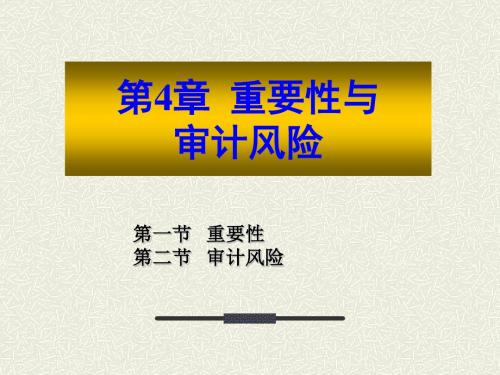
第一节 重要性
二、重要性的运用
(二)将重要性的初步判断分配于各个账户(可 容忍错误) 实际工作中审计重要性的分配是一个非常困 难的职业判断问题。
审计人员的考虑因素: ●各账户和种类交易的性质及错报和漏 报的可能性 ●账户余额的重要性水平和会计报表重 要性水平的关系P59
(一)对重要性作出初步判断 重要性的初步判断是指审计人员认为会计报表可以 出现而又不致影响有理性的人员作出决策的最大错报数 额。 1.影响重要性判断的因素
●重要性是相对概念而非绝对概念 ●评价重要性的基础 税前净利润、资产总额是最常见的基础,另外不同的目的也有 不同的重要性基础 ●质量因素对重要性的影响 错误行为的性质、可能引起法律上的义务、影响到相关数据的 趋势
张华林:《审计学》 第4章 重要性与审计风险 6
第一节 重要性 二、重要性的运用
(一)对重要性作出初步判断 2.重要性指南
●一般标准:5%、10% ●利润表标准:税前利润5%~10% 资产负债表标准:流动资产或流动负债 5%~10%、总资产3%~6% ●质量因素对标准的影响很大
张华林:《审计学》 第4章 重要性与审计风险 7
第4章 重要性与 审计风险
第一节 重要性 第二节 审计风险
教学目的与要求
理解
影响审计风险的因素 审计风险模型
掌握
重要性及其判断 审计风险与固有风险、控制风险和检查风险的关
系
张华林:《审计学》 第4章 重要性与审计风险
2
教学重点与难点
重要性
审计风险模型
张华林:《审计学》 第4章 重要性与审计风险
张华林:《审计学》 第4章 重要性与审计风险 9
01总论

(2)经济业务发生后,首先要按会计科目 对经济业务进行分类核算,并运用复式记 账法在有关会计账簿中进行登记( √ )
总论
29
第二节会计基本假设
一、会计主体 二、持续经营 三、会计分期 四、货币计量
总论
30
会计基本假设
它是据以进行会计核算的基础性假定,是 会计人员对会计核算所处的变化不定的环 境做出的合理判断,是会计核算的基础条 件,是保证会计顺利进行的前提。 会计核算对象的确定、会计方法的选择、 会计数据的收集都以会计核算的基本假设 为依据。
总论
37
三、会计分期
由于会计分期,产生了当期与其他期间的 差别,从而出现权责发生制和收付实现制 的区别,进而出现了应收、应付等会计处 理方法。
总论
38
四、货币计量
以货币为统一的主要的计量单位,记录和 反映企业生产经营过程和经营成果。
两层含义:
以货币作为主要的计量尺度(而不是唯一) 假定币值稳定:这样不同时点的资产的价值才有 可比性,不同期间的收入和费用才能进行比较 (否则,应采用通货膨胀会计)
偿债、分红等 供应过程 原材料、设备 生 产 过 程 产成品 投资活动 被投资者 (资本市场) 销售过程
投资者、债权人 (资本市场) 筹资活动
发行股票、 债券、借款 购入股票、债券等
现金 (企业)
经营活动
总论 转让股票、债券等
24
(1)会计的对象是特定主体的( (2)企业的资金运动表现为( (3)资金循环主要包括(
成都东软学院—基础会计
总论
张艳玲
财务教研室
案例引入
你准备经营一个规模不大的小超市,作为投资人 和经营者,你要负责日常的经营管理、进货及销 售,因此你雇了一个名叫韦小宝的会计负责日常 的收支核算和记账,又雇了刘德华帮忙理货及处 理一些杂事。 问题:
第一章 总论
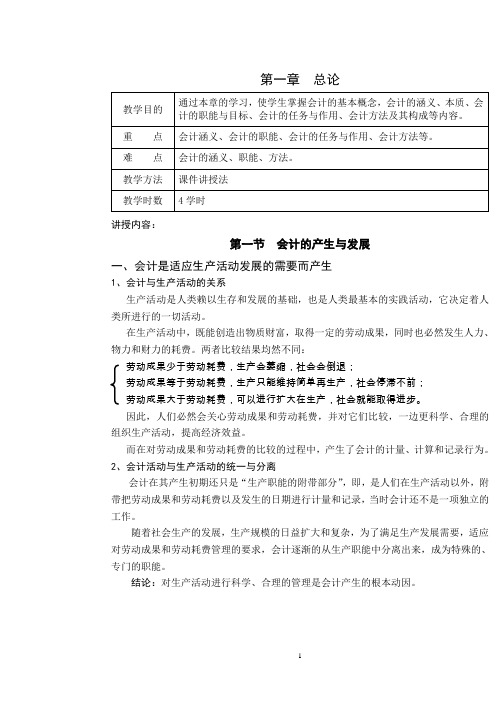
第一章总论讲授内容:第一节会计的产生与发展一、会计是适应生产活动发展的需要而产生1、会计与生产活动的关系生产活动是人类赖以生存和发展的基础,也是人类最基本的实践活动,它决定着人类所进行的一切活动。
在生产活动中,既能创造出物质财富,取得一定的劳动成果,同时也必然发生人力、物力和财力的耗费。
两者比较结果均然不同:劳动成果少于劳动耗费,生产会萎缩,社会会倒退;劳动成果等于劳动耗费,生产只能维持简单再生产,社会停滞不前;劳动成果大于劳动耗费,可以进行扩大在生产,社会就能取得进步。
因此,人们必然会关心劳动成果和劳动耗费,并对它们比较,一边更科学、合理的组织生产活动,提高经济效益。
而在对劳动成果和劳动耗费的比较的过程中,产生了会计的计量、计算和记录行为。
2、会计活动与生产活动的统一与分离会计在其产生初期还只是“生产职能的附带部分”,即,是人们在生产活动以外,附带把劳动成果和劳动耗费以及发生的日期进行计量和记录,当时会计还不是一项独立的工作。
随着社会生产的发展,生产规模的日益扩大和复杂,为了满足生产发展需要,适应对劳动成果和劳动耗费管理的要求,会计逐渐的从生产职能中分离出来,成为特殊的、专门的职能。
结论:对生产活动进行科学、合理的管理是会计产生的根本动因。
二、会计是生产活动发展到一定阶段的产物生产活动的发生是会计产生的前提条件,如果没有生产活动,便不会有会计思想和会计行为的产生。
,但这不意味着生产活动一发生,就产生了会计,研究表明,只有当人类的生产活动发展到一定阶段,特别是劳动成果有剩余时,会计的计量、记录行为才具备了产生的条件。
结论:会计是生产活动发展到一定阶段的产物。
三、会计的发展经历了一个漫长的历史过程1、会计发展的三个重要阶段(1)古代会计阶段(奴隶社会会计产生-1494年)在原始社会,对生产活动的计算和计量仅凭部落首领的头脑记忆即可。
当生产力发展到一定水平的时候,生产活动频繁,劳动产品增加,剩余产品出现,单凭头脑计算和记忆已远远不够,于是产生了“结绳记事”、“刻竹作书” 等记录和计算方法。
第一章 总论 - 原始

失去监督,绝对权力导致绝对的腐败
张家岭曾经略带得意地说过:兼任董事长调动资金就方 便,下属知道我用钱了,也不会问钱是公用还是私用。
“上梁不正下梁歪”
张家岭的所作所为潜移默化地影响了班子成员和中层 干部中的个别人。他们心思游离于工作之外,或跑官要 官、投机钻营,或结党营私、中饱私囊。
我们要讨论的是,在两大事件中,美国政府是如何力挽狂澜,化被动为主动来解决这种危机 的,这是值得我们学习和讨论的。911之后,美国和全世界人民反恐,和各国人民协商,得
到各国人民的一个理解,同情和支持,美国在911之后,几乎是一正一负,极大改善了他的
国际形象和国际地位,这是一个很好的契机,21世纪以来美国形象很好的一个扭转,可以说 是打了一个平手。但对安然事件的影响,安然事件不是安然一个事件,而是因此引发的整个 会计丑闻这套体系,安然事件之后美国萨班斯-奥克斯利法案。
、内部控制及外部审计同时做出了严格的要求。
——保证财务信息的真实
对美国影响重大的两大事件? 911事件和安然事件哪个对美国影响大?
911后让世界人民都解气,因为美国很霸权很强权,911之后它老实多了。但告诉各位,美国 真正谦虚下来,低下他高贵头颅的时候是安然事件,安然事件反映的是什么?是整个制度,
5200万美元的收入来自安然公司,而这其中2700万美元是管理咨询业务收入 ,只有2500万美元才是审计鉴证收入。很显然,安达信担任安然公司的独立
审计师可谓扮演了双重角色:外部审计师和内部审计师。因此,安达信的审
计失去独立性,无法做到公正。正如美国《商业周刊》评论员所说:“一只 手做账?另一只手证明这只手做的账”,这样,怎能不出假账?从安然案爆
析,安然的盈利率在2000年为5%,到了2001年初就降到2%以下,对于投资
第一章 总论
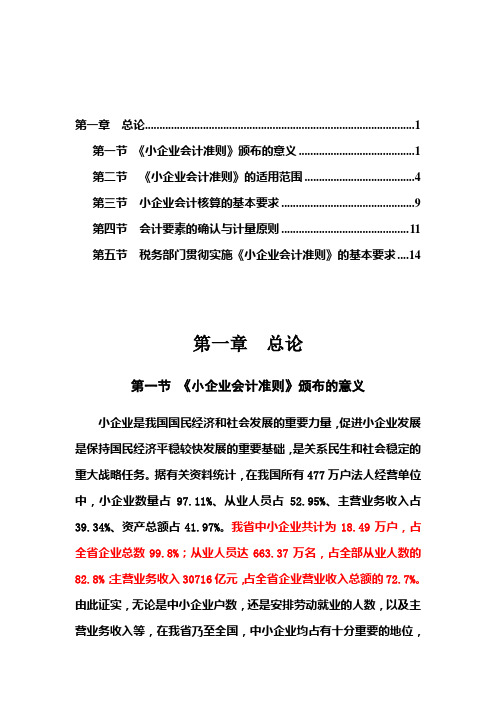
第一章总论 (1)第一节•小企业会计准则‣颁布的意义 (1)第二节•小企业会计准则‣的适用范围 (4)第三节小企业会计核算的基本要求 (9)第四节会计要素的确认与计量原则 (11)第五节税务部门贯彻实施•小企业会计准则‣的基本要求 (14)第一章总论第一节《小企业会计准则》颁布的意义小企业是我国国民经济和社会发展的重要力量,促进小企业发展是保持国民经济平稳较快发展的重要基础,是关系民生和社会稳定的重大战略任务。
据有关资料统计,在我国所有477万户法人经营单位中,小企业数量占97.11%、从业人员占52.95%、主营业务收入占39.34%、资产总额占41.97%。
我省中小企业共计为18.49万户,占全省企业总数99.8%;从业人员达663.37万名,占全部从业人数的82.8%;主营业务收入30716亿元,占全省企业营业收入总额的72.7%。
由此证实,无论是中小企业户数,还是安排劳动就业的人数,以及主营业务收入等,在我省乃至全国,中小企业均占有十分重要的地位,是国民经济和社会发展不可忽视的重要力量。
因此,促进中小企业发展,是保持国民经济平稳较快发展的重要基础,是民生和社会稳定的重大战略任务。
中央高度重视支持小企业发展,先后于2003年出台了•中华人民共和国中小企业促进法‣、2005年出台了•国务院鼓励支持和引导个体私营等非公有制经济发展的若干意见‣(国发…2005‟3号),特别是2009年9月,国务院印发了•国务院关于进一步促进中小企业发展的若干意见‣(国发…2009‟36号),提出了进一步扶持中小企业发展的综合性政策措施。
为了规范小企业会计确认、计量和报告行为,促进小企业可持续发展,2009年11月,财政部开始着手制定•小企业会计准则‣。
经过两年的精心准备,2011年10月,财政部颁布了•小企业会计准则‣,自2013年1月1日起在全国小企业范围内施行。
但是以下四个类别的小企业不得执行•小企业会准则‣(一)股票或债券在市场上公开交易的小企业。
第一章 总论

第一章总论1.1 项目背景随着社会经济发展和全民自然保护意识增强,北京市的生物多样性保护和自然保护区建设事业取得了长足的发展。
至今,北京市已建成各级各类自然保护区20个,总面积13.6万hm2。
其中国家级1个、省级13个、县级6个。
这些保护区覆盖了北京周边大范围的森林生态系统和湿地生态系统,有效保护了北京地区的生物多样性,构成北京地区重要的生态屏障。
白河堡自然保护区是北京自然保护网络的重要组成之一,位于北京市延庆县境内,总面积7973.1hm2,1999年12月被北京市政府以市政府京政函[1999]168号文件批复为县级自然保护区,以法律的形式加以保护。
保护区主要保护以饮用水源、黑鹳等为代表的珍稀水鸟、水源涵养林等为主要对象的水域湿地生态系统和森林生态系统。
白河堡水库是北京的第五大水库,控制流域面积2657km2,是一座具有防洪、补水、灌溉、发电、水产养殖等多种综合效益和跨流域沟通密云、官厅、十三陵三大水库进行水资源再分配的水利枢纽工程。
白河堡引水工程是一项跨流域调水工程,一方面,通过白河向密云水库补水,作为密云水库的应急水源和重要的“后备军”;另一方面,经妫水河向官厅水库输水,缓和京西电力、钢铁等工业用水紧张局面;第三,向十三陵水库补水,为十三陵水库发展旅游提供有利条件,而且为十三陵水库蓄能电站建设提供水源保证。
因此,建立白河堡自然保护区,保护好白河堡水库对保证首都用水安全、促进首都经济发展、提高首都人民生活水平具有重要的现实意义。
白河堡自然保护区是北京地区自然保护区网络中重要的组成部分,是京西北重要的水域湿地生态系统,它是多种鸟类和水生生物的栖息、繁殖场所,是许多珍稀濒危鸟类迁徙的停留栖息地和中转站。
因此,保护典型的水域湿地生态系统、维护区域生态平衡、实现人与自然的和谐发展,是保护区建设的重要内容。
白河堡自然保护区位于华北平原向冀西北山间盆地、内蒙古高原过渡地带,是华北平原植物亚地区和华北山地植物亚地带的交接处,森林资源十分丰富。
1第1章总论

第1 章
1.1.1 财务会计定义
总论
财务会计(Financial Accounting)是以货
币为主要计量单位,依据《企业会计准则》等 会计规范,运用若干普遍接受的会计惯例,通 过确认、计量和报告等专门程序和方法,向财 务报告使用者提供有关企业财务状况、经营成 果、现金流量等会计信息为主的经济信息系统。
某件企业在年初用银行存款支付本年租金 120 000元,于1月末仅将其中的10 000元 计入本月费用,这符合( ) A 收付实现制 B 权责发生制 C 谨慎性原则 D 历史成本计价原则
收付实现制:以收到或支付的现金作为确 认收入和费用等的依据。 目前我国的行政单位会计采用收付实现制 ,事业单位会计除经营业务可以采用权责 发生制,其他大部分业务采用收付实现制 。
财务会计实务 陈强
学习方法
3.认真复习,勤于练习。每次听课后,要对照自己的课堂笔记 认真地进行复习,然后在复习的基础上,认真完成每章的练习 题,由于各题安排的内容都不相似,覆盖的领域不同,只有逐 章逐题认真去做,才能通过练习更好地理解这一章中覆盖的全 部内容,切忌贪图省力、省时,取巧挑做,以致忽略了复习和 理解其他部分,削弱自己的解题能力。
第1 章
1.1.2 财务会计目标
总论
决策有用观
财务会计实务 陈强
为谁提供会计信息?
会计信息外部使用者
股东 债权人 政府机关 职工
会计信息内部使用者
董事会
首席执行官(CEO)
首席财务官(CFO) 企业管理者
供应商
顾客
第1 章
1.1.2 财务会计目标
总论
受托责任观
第一章总论

现行财务制度规定,产品成本开支范围: 现行财务制度规定,产品成本开支范围:
为制造产品消耗的原材料、辅助材料、 1、为制造产品消耗的原材料、辅助材料、外购半成 品及燃料等费用; 品及燃料等费用; 为制造产品而耗用的动力费; 2、为制造产品而耗用的动力费; 支付给生产工人的工资、奖金、 3、支付给生产工人的工资、奖金、津贴和提取的福 利费; 利费; 生产性固定资产折旧费、租赁费、 4、生产性固定资产折旧费、租赁费、修理费和周转 材料的摊销费用; 材料的摊销费用; 5、因生产原因发生的废品损失以及季节性和修理期 间的停工损失; 间的停工损失; 为组织和管理生产而支付的办公费、水电费、 6、为组织和管理生产而支付的办公费、水电费、差 旅费,以及运输费、保险费、设计制图费、 旅费,以及运输费、保险费、设计制图费、试验 检验费和劳动保护费等。 检验费和劳动保护费等。
支出、费用、 支出、费用、成本的关系
1.支出 支出 是指企业的一切开支与耗费。 是指企业的一切开支与耗费。一般包括资本性支 收益性支出、所得税支出、 出、收益性支出、所得税支出、营业外支出和利润分 配性支出五大类。 配性支出五大类。 2.费用 费用 是指企业为销售商品、 是指企业为销售商品、提供劳务等日常活动发生 的经济利益的总流出。费用强调的是归属于某一期间, 的经济利益的总流出。费用强调的是归属于某一期间, 而成本强调的是费用承担的对象,是对象化的费用。 而成本强调的是费用承担的对象,是对象化的费用。 费用按其与产品的关系分为生产费用和期间费用
三者之间的关系图
支出
Hale Waihona Puke 不列为费用的支出费用
生产费用(成本)
期间费用
未完工产品成本
已完工产品成本
营业费用
管理费用
第一章 总论
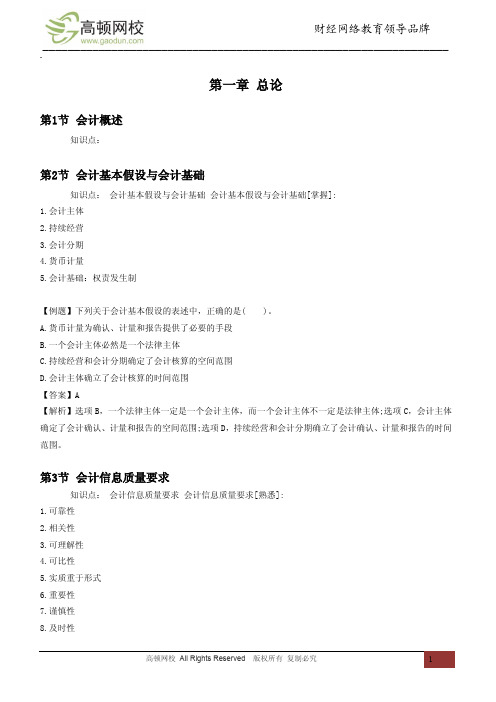
第一章总论第1节会计概述知识点:第2节会计基本假设与会计基础知识点:会计基本假设与会计基础会计基本假设与会计基础[掌握]:1.会计主体2.持续经营3.会计分期4.货币计量5.会计基础:权责发生制【例题】下列关于会计基本假设的表述中,正确的是( )。
A.货币计量为确认、计量和报告提供了必要的手段B.一个会计主体必然是一个法律主体C.持续经营和会计分期确定了会计核算的空间范围D.会计主体确立了会计核算的时间范围【答案】A【解析】选项B,一个法律主体一定是一个会计主体,而一个会计主体不一定是法律主体;选项C,会计主体确定了会计确认、计量和报告的空间范围;选项D,持续经营和会计分期确立了会计确认、计量和报告的时间范围。
第3节会计信息质量要求知识点:会计信息质量要求会计信息质量要求[熟悉]:1.可靠性2.相关性3.可理解性4.可比性5.实质重于形式6.重要性7.谨慎性8.及时性【例题】下列做法中,违背可比性会计信息质量要求的有( )。
A.因预计发生年度亏损,将以前年度计提的存货跌价准备全部予以转回B.因本年利润计划完成情况不佳,决定暂停无形资产的摊销C.因客户的财务状况好转,将坏账准备的计提比例由应收账款余额的30%降为15%D.因专利申请成功,将已计入前期损益的研究费用转为无形资产成本E.因减持股份对被投资单位不再具有重大影响,将长期股权投资由权益法改为成本法核算【答案】ABD【解析】选项A,原来导致减值的因素消失,存货跌价准备才能转回;选项B,不能根据企业的经营情况任意调整无形资产的摊销额;选项D,研究费用应该计入当期损益,专利申请成功后也不能转为无形资产。
参与注册会计师考试的考生可按照复习计划有效进行,另外高顿网校官网考试辅导高清课程已经开通,还可索取注会考试通关宝典,针对性地讲解、训练、答疑、模考,对学习过程进行全程跟踪、分析、指导,可以帮助考生全面提升备考效果。
更多详情可登录高顿网校官网进行咨询。
第一章 总论

第2讲-总论(1)第一章总论本章教材考情分析本章属于基础性知识,在考试中所占比重不大,一般以客观题形式出现。
每年分值在2分左右。
本章教材主要变化本章教材无实质性变化。
本章基本结构框架第一节会计概述一、会计的定义会计,是以货币为主要计量单位,反映和监督一个单位经济活动的一种经济管理工作。
二、会计的作用(3方面)1.提供决策有用信息,提高企业透明度,规范企业行为。
2.加强经营管理,提高经济效益,促进企业可持续发展。
3.考核企业管理层经济责任的履行情况。
三、企业会计准则的制定与企业会计准则体系中国现行企业会计准则体系由基本准则、具体准则、应用指南和解释组成。
第三节会计信息质量要求一、可靠性(强调真实)二、相关性(强调有用)三、可理解性(清晰明了)四、可比性(一)同一企业不同时期可比(纵向可比)会计信息质量的可比性要求同一企业不同时期发生的相同或者相似的交易或者事项,应当采用一致的会计政策,不得随意变更。
(二)不同企业相同会计期间可比(横向可比)五、实质重于形式实质重于形式要求企业应当按照交易或者事项的经济实质进行会计确认、计量和报告,不仅仅以交易或者事项的法律形式为依据。
【举例】企业以融资租赁方式租入固定资产形式:没有所有权实质:承租方长期占有使用结论:当作承租方资产,不是自有,视同自有【举例】企业在销售某商品的同时又与客户签订了售后回购协议。
(以事先约定的价格)形式:销售商品实质:筹集资金结论:不确认收入【补充例题•单选题】(2014年)下列各项中,体现实质重于形式这一会计信息质量要求的是()。
A.确认预计负债B.对应收账款计提坏账准备C.对外公布财务报表时提供可比信息D.将融资租入固定资产视为自有资产入账【答案】D【解析】融资租入固定资产视同自有资产核算,符合会计信息质量要求的实质重于形式原则,其他选项不符合。
【补充例题•多选题】(2015年)下列各项交易事项的会计处理中,体现实质重于形式原则的有()。
2008年第8期
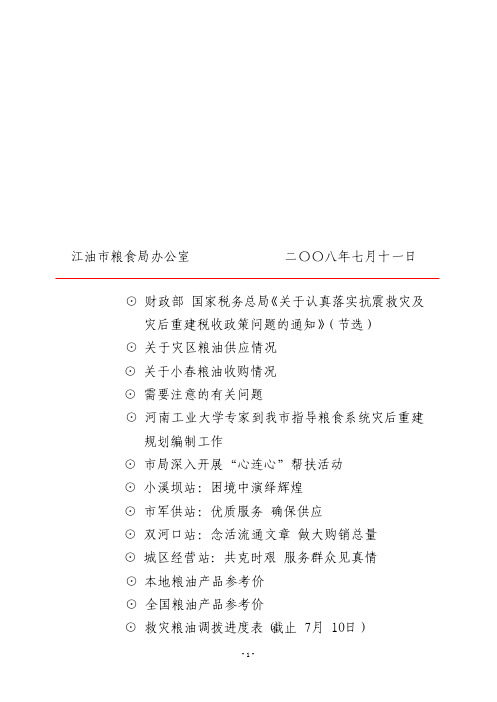
江粮简讯 2008年第8期 (总第19期) 江油市粮食局办公室 二〇〇八年七月十一日 政策讯息⊙ 财政部 国家税务总局《关于认真落实抗震救灾及灾后重建税收政策问题的通知》(节选) 工作动态⊙ 关于灾区粮油供应情况 ⊙ 关于小春粮油收购情况 ⊙ 需要注意的有关问题 信息摘编⊙ 河南工业大学专家到我市指导粮食系统灾后重建规划编制工作 ⊙ 市局深入开展“心连心”帮扶活动 ⊙ 小溪坝站:困境中演绎辉煌 ⊙ 市军供站:优质服务 确保供应 ⊙ 双河口站:念活流通文章 做大购销总量 ⊙ 城区经营站:共克时艰 服务群众见真情 粮情快讯⊙ 本地粮油产品参考价 ⊙ 全国粮油产品参考价 ⊙ 救灾粮油调拨进度表(截止7月10日) 政 策 讯 息 各级财政税务机关要将支持抗震救灾和灾后重建工作作为当前一项十分紧迫的重要任务,采取有效措施,认真贯彻落实好现行税收法律、法规中可以适用于抗震救灾及灾后重建的有关税收优惠政策。
主要包括: 企业所得税:(一)企业实际发生的因地震灾害造成的财产损失,准予在计算应纳税所得额时扣除。
(二)企业发生的公益性捐赠支出,按企业所得税法及其实施条例的规定在计算应纳税所得额时扣除。
个人所得税:(一)因地震灾害造成重大损失的个人,可减征个人所得税。
具体减征幅度和期限由受灾地区省、自治区、直辖市人民政府确定。
(二)对受灾地区个人取得的抚恤金、救济金,免征个人所得税。
(三)个人将其所得向地震灾区的捐赠,按照个人所得税法的有关规定从应纳税所得中扣除。
房产税:(一)经有关部门鉴定,对毁损不堪居住和使用的房屋和危险房屋,在停止使用后,可免征房产税。
(二)房屋大修停用在半年以上的,在大修期间免征房产税,免征税额由纳税人在申报缴纳房产税时自行计算扣除,并在申报表附表或备注栏中作相应说明。
城镇土地使用税:纳税人因地震灾害造成严重损失,缴纳确有困难的,可依法申请定期减免城镇土地使用税。
(摘财政部、国家税务总局《关于认真落实抗震救灾及灾后重建税收政策问题的通知》) 工 作 动 态 根据国务院对受灾群众每天补助1斤救济粮的政策,按照省政府办公厅《关于做好抗震救灾粮食筹措与供应的通知》(川府办发电[2008]60号)规定,市粮食局按照围绕“两条战线”(即供应线和收购线),做好“六项重点工作”的思路,加强领导,精心组织,克服重重困难,确保了灾区救济粮的供应和小春粮油收购,为全市夺取抗震救灾全面胜利提供了必要的保障。
1 总论
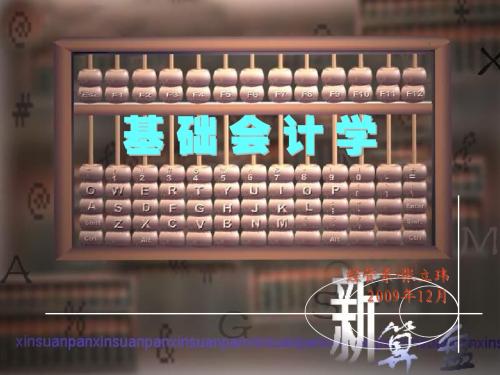
会计准则反映经济活动、确认产权关系、规范收益分配的会计技术分
配的会计技术标准,是生成和提供会计信息的重要依据;是资本市场的一种重 要游戏规则,是实现社会资源优化配置的重要依据;是国家、社会规范乃至强 制性规范的重要组成部分。是我国经济法规的一个组成部分,是组织和从事会 计工作必须遵循的规范。 我国财政部于2006年 我国财政部于2006年2月15日发布 15日发布 了新《企业会计准则》 了新《企业会计准则》,要求上市公司 从2007年1月1日起施行。我国会计准则 2007年 划分为三个层次:
第一章 总论
(一)基本准则
基本准则是进行会计核算工作必须遵守的基本要求。
1、基本准则内容 基本准则规范的核心内容包括六个方面: 财务报告目标; 会计基本假定; 会计基础; 会计信息质量要求; 会计要素分类及其确认、计量原则; 财务会计报告。
第一章 总论
(二)具体会计准则
具体准则主要是依据基本准则的要求,规范企 主要是依据基本准则的要求,
第十一章 会计工作的组织
第一章 总论
第一章 总论
教学目的及要求
通过本章的学习,要求学生理解会计的内涵、 特点和会计职能,掌握会计基本假定和会计信 息质量要求,了解我国会计法规体系的基本内 容及相互关系,理解会计计量。
教学重点 教学难点
会计特点、会计核算的基本前提、会计信息 质量要求 会计基本假定、会计计量
权责发生制
收付实现制
第一章 总论
四、 会计信息质量要求
对企业财务报告中所提供会计信息质量 的基本要求, 的基本要求, 是使财务报告中所提供会计信息对投资者等使决策有用 应具备的基本特征,根据基本准则规定,它包括八项质量要求。
会计信息质量要求
第一章 总论
zhanglin2008
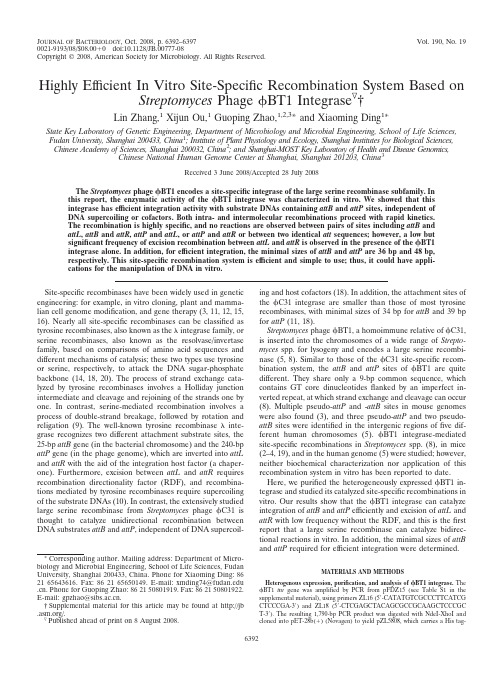
J OURNAL OF B ACTERIOLOGY,Oct.2008,p.6392–6397Vol.190,No.19 0021-9193/08/$08.00ϩ0doi:10.1128/JB.00777-08Copyright©2008,American Society for Microbiology.All Rights Reserved.Highly Efficient In Vitro Site-Specific Recombination System Based on Streptomyces PhageBT1Integraseᰔ†Lin Zhang,1Xijun Ou,1Guoping Zhao,1,2,3*and Xiaoming Ding1* State Key Laboratory of Genetic Engineering,Department of Microbiology and Microbial Engineering,School of Life Sciences, Fudan University,Shanghai200433,China1;Institute of Plant Physiology and Ecology,Shanghai Institutes for Biological Sciences, Chinese Academy of Sciences,Shanghai200032,China2;and Shanghai-MOST Key Laboratory of Health and Disease Genomics, Chinese National Human Genome Center at Shanghai,Shanghai201203,China3Received3June2008/Accepted28July2008The Streptomyces phageBT1encodes a site-specific integrase of the large serine recombinase subfamily.Inthis report,the enzymatic activity of theBT1integrase was characterized in vitro.We showed that thisintegrase has efficient integration activity with substrate DNAs containing attB and attP sites,independent ofDNA supercoiling or cofactors.Both intra-and intermolecular recombinations proceed with rapid kinetics.The recombination is highly specific,and no reactions are observed between pairs of sites including attB andattL,attB and attR,attP and attL,or attP and attR or between two identical att sequences;however,a low butsignificant frequency of excision recombination between attL and attR is observed in the presence of theBT1integrase alone.In addition,for efficient integration,the minimal sizes of attB and attP are36bp and48bp,respectively.This site-specific recombination system is efficient and simple to use;thus,it could have appli-cations for the manipulation of DNA in vitro.Site-specific recombinases have been widely used in genetic engineering:for example,in vitro cloning,plant and mamma-lian cell genome modification,and gene therapy(3,11,12,15, 16).Nearly all site-specific recombinases can be classified as tyrosine recombinases,also known as theintegrase family,or serine recombinases,also known as the resolvase/invertase family,based on comparisons of amino acid sequences and different mechanisms of catalysis;these two types use tyrosine or serine,respectively,to attack the DNA sugar-phosphate backbone(14,18,20).The process of strand exchange cata-lyzed by tyrosine recombinases involves a Holliday junction intermediate and cleavage and rejoining of the strands one by one.In contrast,serine-mediated recombination involves a process of double-strand breakage,followed by rotation and religation(9).The well-known tyrosine recombinaseinte-grase recognizes two different attachment substrate sites,the 25-bp attB gene(in the bacterial chromosome)and the240-bp attP gene(in the phage genome),which are inverted into attL and attR with the aid of the integration host factor(a chaper-one).Furthermore,excision between attL and attR requires recombination directionality factor(RDF),and recombina-tions mediated by tyrosine recombinases require supercoiling of the substrate DNAs(10).In contrast,the extensively studied large serine recombinase from Streptomyces phageC31is thought to catalyze unidirectional recombination between DNA substrates attB and attP,independent of DNA supercoil-ing and host cofactors(18).In addition,the attachment sites of theC31integrase are smaller than those of most tyrosine recombinases,with minimal sizes of34bp for attB and39bp for attP(11,18).Streptomyces phageBT1,a homoimmune relative ofC31, is inserted into the chromosomes of a wide range of Strepto-myces spp.for lysogeny and encodes a large serine recombi-nase(5,8).Similar to those of theC31site-specific recom-bination system,the attB and attP sites ofBT1are quite different.They share only a9-bp common sequence,which contains GT core dinucleotidesflanked by an imperfect in-verted repeat,at which strand exchange and cleavage can occur (8).Multiple pseudo-attP and-attB sites in mouse genomes were also found(3),and three pseudo-attP and two pseudo-attB sites were identified in the intergenic regions offive dif-ferent human chromosomes(5).BT1integrase-mediated site-specific recombinations in Streptomyces spp.(8),in mice (2–4,19),and in the human genome(5)were studied;however, neither biochemical characterization nor application of this recombination system in vitro has been reported to date. Here,we purified the heterogeneously expressedBT1in-tegrase and studied its catalyzed site-specific recombinations in vitro.Our results show that theBT1integrase can catalyze integration of attB and attP efficiently and excision of attL and attR with low frequency without the RDF,and this is thefirst report that a large serine recombinase can catalyze bidirec-tional reactions in vitro.In addition,the minimal sizes of attB and attP required for efficient integration were determined.MATERIALS AND METHODSHeterogenous expression,purification,and analysis ofBT1integrase.The BT1int gene was amplified by PCR from pFDZ15(see Table S1in the supplemental material),using primers ZL16(5Ј-CATATGTCGCCCTTCATCG CTCCCGA-3Ј)and ZL18(5Ј-CTCGAGCTACAGCGCCGCAAGCTCCCGC T-3Ј).The resulting1,790-bp PCR product was digested with NdeI-XhoI and cloned into pET-28b(ϩ)(Novagen)to yield pZL5808,which carries a His tag-*Corresponding author.Mailing address:Department of Micro-biology and Microbial Engineering,School of Life Sciences,Fudan University,Shanghai200433,China.Phone for Xiaoming Ding:86 2165643616.Fax:862165650149.E-mail:xmding74@.cn.Phone for Guoping Zhao:862150801919.Fax:862150801922.E-mail:gpzhao@.†Supplemental material for this article may be found at http://jb/.ᰔPublished ahead of print on8August2008.6392fused N-terminal BT1integrase gene.BL21(DE3)(Novagen),freshly trans-formed with pZL5808,was grown with 2ϫYT (13)at 37°C for 3to 4h until late log phase (optical density at 600nm,0.8to 1.0).Isopropyl -D -1-thiogalactopy-ranoside (IPTG)was added to give a final concentration of 0.1mM to induce expression of the integrase,and growth at 20°C was continued overnight (10to 16h).After the cells were harvested by centrifugation,the pellets were resuspended,ultrasonicated,and subjected to Ni-nitrilotriacetic acid (NTA)purification ac-cording to the manufacturer’s instructions (Invitrogen Ni-NTA purification sys-tem).The fractions containing integrase were maintained in TEDS buffer (20mM Tris-HCl,2mM EDTA,1mM dithiothreitol,1M NaCl,pH 8.0)and concentrated by ultrafiltration (Millipore)to give a final concentration of 3mg/ml.After the addition of glycerol to give a final concentration of 50%(vol/vol),the purified protein was stored at Ϫ30°C.For the further purity of the integrase,gel filtration was performed using a Superdex 20010/300GL column (Amersham Biosciences)connected to a fast protein liquid chromatography system (GE AKTA purifier).The integrase peak fractions were pooled and concentrated by ultrafiltration.One unit of enzymatic activity was defined as the amount of enzyme necessary to produce 50%site-specific recombination of 100ng linearized attB -attP DNA in a total reaction volume of 10l in 30min at 30°C,as described below.Construction of plasmids and preparation of DNA fragments for in vitro recombination reactions.The plasmids used in this study are listed in Table S1in the supplemental material.Preparation of the Streptomyces coelicolor M145genomic DNA was performed as described by Kieser et al.(13).The S.coelicolor chromosomal fragment containing attB (886bp)was PCR amplified using prim-ers ZL24(5Ј-TGGACCCGGAGCCGATGC-3Ј)and ZL25(5Ј-CGGAACAGA CGCCGCCAC-3Ј).The resulting PCR product was cloned into the Takara T-cloning vector pMD19and designated pZL5812.Plasmid pZL5811(int Ϫ)is a derivative of pRT802(int ϩ),in which the int gene is disrupted by deletion of an internal EcoRI fragment but the attP site is maintained.Plasmids pZL5813(int ϩ)and pZL5814(int Ϫ),containing attL and attR ,respectively,in directorientations,FIG.1.In vitro recombination between attB and attP catalyzed by BT1integrase.(A)Fractions from each purification step were obtained and analyzed by sodium dodecyl sulfate-polyacrylamide gel electrophoresis.BT1integrase (68.2kDa)displayed a band corresponding to the molecular mass marker of 66kDa.Shown are total cell proteins from lysed BL21(DE3)/pZL5808with (lane 1)or without (lane 2)IPTG induction,crude cell extract (lane 3),Ni-NTA column flowthrough (lane 4),four continuous fractions eluted from the column (lanes 5to 8),gel filtration-purified protein (lane 9),and molecular markers (lane M).(B)Schematic diagrams of the substrates used;the expected recombination products are shown in panels C and E.(C)Recombination between supercoiling or linearized plasmids pZL5811and pZL5812(lanes 1to 6).Substrates or the products were digested with Kpn ⌱,followed by gel analysis.Supercoiled plasmid pZL5815containing attB and attP was used as the substrate,and the recombinant products were digested with EcoRI,followed by gel electrophoresis (lanes 7and 8).Multi-attR products in the assays were due to inter-and intramolecular reactions (see scheme in panel D for the mechanisms).(D)Schematic diagrams of the substrates used and the expected recombination products shown in panels C and F.(E)Time course of in vitro integration between two linearized att fragments,pZL5811and pZL5812,predigested with Kpn ⌱,illustrated as the scheme in panel B.The reaction times are indicated.(F)Time course of recombination with a substrate of linearized pZL5815DNA containing attB and attP in direct orientation (see scheme in panel D).The reaction times are indicated.V OL .190,2008BT1INTEGRASE-BASED IN VITRO RECOMBINATION 6393were obtained byBT1integrase-mediated in vitro site-specific integration; plasmid pZL5812(containing attB resistant to ampicillin)was recombined with plasmid pRT802or pZL5811(containing attP resistant to kanamycin),and trans-formants were then screened using kanamycin and ampicillin.Plasmid pZL5814 was digested by EcoRI and self-ligated to obtain plasmid pZL5816or pZL5817, containing only attL or attR,respectively.Plasmid pZL5815,containing attB and attP in direct orientation,was constructed by inserting the716-bp BoxI-KpnI fragment from pZL5812into pZL5811.Plasmid pDZY101was constructed for Streptomyces mutagenesis;this plasmid encodes a novel transposon and contains aBT1attP site.All substrate DNA sequences used for determination of recombination direc-tionality were linearized with restriction enzymes before the assays.The restric-tion enzymes and the plasmids and their products after digestion were as follows (schematic diagrams are shown in Fig.S2in the supplemental material):plasmid pZL5812was digested with Box⌱to produce a3,578-bp segment containing attB1, which was digested with BamH⌱and Ssp⌱to produce a2,485-bp segment con-taining attB2;pZL5814was digested with Box⌱to produce a2,611-bp segment containing attL1,which was digested with Nde⌱and Nhe⌱to produce a2,957-bp segment containing attL2;pZL5816was digested with EcoR⌱and HindIII to produce a1,623-bp segment containing attL3;pZL5813was digested with Blp⌱to produce a3,624-bp segment containing attR1and digested with Kpn⌱to produce a2,477-bp segment containing attR2,which was digested with Nhe⌱and HindIII to produce an8,188-bp segment containing attR3;pDZY101was digested with BamH⌱and Nru⌱to produce a4,947-bp segment containing attP1,and pZL5811 was digested with Sph⌱and Kpn⌱to produce a2,612-bp segment containing attP2, which was digested with EcoR⌱to produce a4,434-bp segment containing attP3. For intramolecular excision assays,plasmid pZL5813was digested with HindIII to produce an8,724-bp segment containing attL and attR in direct orientations. Standard in vitro recombination assays.Standard recombination was carried out in a reaction mixture(10l)containing10mM Tris-HCl,pH8.0,100mM KCl,and integrase(4U in0.5l).The reaction mixtures were incubated at30°C for30min,and the reactions were terminated by heat inactivation at75°C for10 min;the products were separated by electrophoresis on agarose gels.Reaction mixtures using supercoiled plasmids as substrates were heat inactivated,precip-itated with ethanol,and dissolved in distilled water for digestions and then separated by agarose gel electrophoresis.A linearized DNA fragment termed attB-attP was prepared by digestion of plasmid pZL5815with EcoR⌱for activity unit definition.The amount of DNA recombination was determined by agarose gel electrophoresis and optical-den-sity-scanning analysis.Unless otherwise indicated,4U integrase was used for each reaction.RESULTS AND DISCUSSIONIsolation of theBT1integrase.The〉⌻1integration sys-tem has been used for genomic manipulations in streptomy-cete,mouse,and human cells in vivo(4,5,8,19).To charac-terize the enzymatic properties of the〉⌻1recombinase in vitro,we expressed the int gene product in Escherichia coli and purified the recombinant integrase to near homogeneity by using the procedures described in Materials and Methods. Figure1A shows the isolated enzyme,with a purity of90to 95%as determined by optical-density-scanning analysis of the Coomassie blue-stained sodium dodecyl sulfate-polyacryl-amide gel electrophoresis gel.Table1summarizes the isolation of the〉⌻1recombinase,which resulted in threefold purifi-cation overall and43%recovery.To avoid precipitation of the enzyme,the〉⌻1recombinase was kept in buffer containing 1M NaCl.TheBT1integrase catalyzes site-specific integration effi-ciently.We developed in vitro assays to monitor the activity of BT1integrase(see Materials and Methods).To assess inter-molecular integration,purified integrase was incubated with two supercoiled plasmids containing equimolar amounts of attB and attP.After digestion with restriction enzymes,inte-gration products of the expected sizes were observed following agarose gel electrophoresis(Fig.1C,lane2).As shown,incu-bation of a pair of supercoiled and linearized plasmids resulted in a level of integration efficiency similar to that observed with supercoiled substrates(Fig.1C,compare lane2with lanes4 and6).Furthermore,when linearized segments containingattB FIG.2.Determination of the directionality ofBT1integrase-me-diated in vitro recombination.(A)In vitro intermolecular recombina-tions using different linearized DNA substrates.The preparation of substrates is described in Materials and Methods.The att substrates determined the positions of attB1(3,578bp;lanes1,2,3,4,and8), attB2(2,485bp;lane8),attP1(4,947bp;lanes1and2),attP2(2,612bp; lane9),attP3(4,434bp;lanes5,6,and9),attL1(2,611bp;lanes5,7, and10),attL2(2,957bp;lanes3and10),attR1(3,624bp;lanes6,7,and 11),and attR2(2,477bp;lanes4and11).If recombination had oc-curred,the product sizes would be markedly different from the sub-strate sizes.Recombination was detected only between attB and attP (lane2)and between attL and attR(lane7).The positions of products attR(8,186bp)and attP(6,061bp)are indicated;the small products attL(362bp)and attB(177bp)could not be detected by agarose gel electrophoresis.Molecular mass markers(M)are the same as those in Fig.1.(B)Brief time course of intermolecular excision recombination between attL3(1,623bp)and attR3(8,188bp).As expected,attB(3,578 bp)and attP(6,233bp)were produced.Incubation times are indicated.(C)Schematic diagrams of the substrates used and the expected re-combination products from panel B.TABLE1.Purification ofBT1integraseFraction source Vol(ml)Amt ofprotein(mg)No.ofintegraseunits a(103)Sp act(no.ofunits/mg)%RecoverySupernatant afterultrasonication4.012.5161,280100Ni-NTA resincolumnflowthrough1.2 3.19.63,10060Gelfiltrate 2.9 2.3 6.82,96043a The unit is defined in Materials and Methods.6394ZHANG ET AL.J.B ACTERIOL.and attP were used as substrates,integration products formed efficiently (Fig.1E).These findings demonstrate the efficient DNA-supercoiling-independent integration of DNAs contain-ing attB and attP .To probe for intramolecular integration,we constructed pZL5815(see Materials and Methods).As shown in Fig.1D,this substrate contains directly oriented attB and attP on the same molecule,and intramolecular integration is expected to produce linear attL and multi-attR products.As shown,incu-bation of supercoiled pZL5815with the BT1integrase fol-lowed by restriction digestion yielded linear attL and multi-attR products (including the single bottom band of attR )of the expected sizes (Fig.1C,lane 8),and linearized pZL5815was efficiently inverted into the integration products (Fig.1F).FIG.3.Determination of minimal attB and attP sizes for efficient in vitro integration.(A)The sequences of the 73-bp attB and attP genes and the schemes of attL and attR are presented.The minimal sequences of attB and attP are underlined,with the 9-bp common sequence highlighted by a box and the GT core dinucleotide shown in bold.The schematic diagrams above and below the sequences illustrate the structural features of the digested fragments containing attB and attP ;these fragments were used for full-length att genes and as the PCR template for generating smaller att fragments,respectively.Solid boxes denote the corresponding minimal sites,hollow arrows denote the primer pairs used for amplification of the att fragments with the left side truncated,and solid arrows denote primers used for amplification of those with the right side truncated.(B)The minimal size of attB was determined using purified attB segments (PCR products amplified from pZL5812;0.3or 0.6kb)and restricted linear attP segments (pDZY101digested with Nhe ⌱and Xho ⌱;5.1kb).Numbers with minus or plus signs denote the shorter attB (attB s )substrate,generated with primers (see Table S3in the supplemental material)at the corresponding positions on the left or right side of attB ,nes C on both sides of the gel contain positive controls in which full-length attB (0.9-kb PCR product)was recombined with attP ,as described above.Molecular mass markers (M)are the same as those in Fig.1.(C)The minimal size of attP was found to be similar to that shown in panel B.Results are shown for reaction mixtures containing attP segments (PCR products amplified from pDZY101;0.3or 0.6kb)and restricted linear attB segments (pZL5812digested with Ssp ⌱,3.6kb).The attB segment for positive controls was a 0.9-kb PCR product.The designations are the same as those used for panel B.V OL .190,2008BT1INTEGRASE-BASED IN VITRO RECOMBINATION 6395Thus,theBT1integrase is highly active in catalyzing intramo-lecular integration.TheBT1integrase can convert more than90%of lin-earized substrates into products within2hours by inter-and intramolecular reactions(Fig.1E and F).This indicates a significantly higher integration rate than those reported for theC31andRv1integrases(1,18);however,this rate seems similar to that of the Bxb1site-specific integration system(6), which shows rapid kinetics.Optimal conditions for theBT1integrase-catalyzed ing the intramolecular integration assays de-scribed above,we determined several parameters for optimal integration by theBT1integrase.We tested a range of pH values and found the optimal pH to be7.0to9.0(see Fig.S1A in the supplemental material).The pH stability of the enzyme was examined by preincubating the integrase at the indicated pH for30min and then assessing its remaining activity at pH 8.0.As shown,the activity and stability curves largely over-lapped(see Fig.S1A in the supplemental material).The optimal temperature forBT1integrase activity was 34°C(see Fig.S1B in the supplemental material).Enzyme stability was determined by preincubation at the indicated tem-peratures for30min followed by activity measurement at30°C. The results show that the enzyme was stable up to32°C but inactivated rapidly when the temperature reached35°C(see Fig.S1B in the supplemental material).Further experiments at 34,35,and36°C revealed that35°C was the transition temper-ature,at which the integrase had a half-life of approximately15 min(see Fig.S1C in the supplemental material).We tested the effects of metal ions and other agents on the activity of theBT1integrase,and the results are summarized in Table S2in the supplemental material.Several metal ions were found to activate integration:Naϩ,Kϩ,Mg2ϩ,and Ca2ϩ(in decreasing order of magnitude of activation).Other metal ions had inhibitory effects.Low concentrations of commonly used protective agents,such as divalent metal chelators or high potential reducing agents,had no significant effects on activity. However,greater concentrations of these agents(10mM) showed some inhibitory effects;the only exceptions were for dithiothreitol and bovine serum albumin.Directionality of theBT1integrase-catalyzed recombina-tion.The directionality ofBT1integrase-mediated in vitro recombination is shown in Fig.2.Linear DNA substrates were designed to differ both in their lengths and in the locations of their att sites in order to distinguish the substrates from the products in the assays(see Fig.S2in the supplemental mate-rial).Although efficient recombination was observed between attB and attP,no recombination was detected between attB and attL or attR,between attP and attL or attR,or between two identical sites of attB,attP,attL,or attR(Fig.2A).However,in contrast to what was found for the other large serine recom-binases,such asC31integrase,Bxb1integrase,andRv1 integrase(1,7,18),in vitro excision between attL and attR was observed(Fig.2A,lane7).Although the efficiency of excision is low,it is significant whenBT1integrase is the only protein present.A time course of excision demonstrated a gradual increase in levels of the attB and attP DNA products(Fig.2B and C).PCR amplification using the products of excision re-actions as templates,followed by sequencing,confirmed that attB and attP were produced(data not shown).Thus,attL and attR were truly inverted into attB and attP during the excision recombination that was catalyzed by the integrase only. Therefore,we conclude that theBT1integrase can catalyze bidirectional site-specific recombinations in the absence of RDF or any cofactors,although the efficiency of excision is low. This is thefirst report that a large serine recombinase can perform excision in vitro,which might account for the obser-vation that none of the integrase-catalyzed reactions could convert all of the DNA substrates containing attB and attP into attL and attR despite prolonged incubation.Minimal substrate sizes of attB and attP for efficient in vitro integration.The minimal attB and attP sizes required for effi-cient integration were determined by in vitro reactions using DNA PCR products of different sizes(Fig.3).A series of primers were designed(see Table S3in the supplemental ma-terial)to amplify the shorter attB(attBs)substrate,in which one side was truncated relative to the GT-dinucleotide core and the other side was unchanged.The PCR product with a 17-bp left side could recombine with full-length attP at an activity level equal to those of the larger products.However, the recombination efficiency of the PCR product with a16-bp left side was markedly reduced(Fig.3B).Thus,we conclude that36bp(17bp for each side,with the GT dinucleotide core in the center)is the minimal size of attB for in vitro integration.A similar series of experiments were performed on attP,and48 bp was found to be the minimal size(Fig.3C).This result was similar to those for other serine recombinases,such asC31 (34bp and39bp,respectively),TP901-1(31bp and50bp), Bxb1(38bp and48bp),andRv1(40bp and52bp)(1,6,10, 11,17).It is therefore likely that a small size difference is a requirement for attB and attP,which may be a common feature of serine site-specific recombination systems(1).In conclusion,this novelBT1integrase-based in vitro site-specific recombination system is highly efficient with defined minimal substrates and could have applications for manipula-tion of DNA in vitro.ACKNOWLEDGMENTSWe thank Margaret C.M.Smith for the gift of plasmid pRT802. This work was supported by grants from the National High Tech-nology Research and Development Program of China(863Program) (no.2007AA021206)and the National Natural Science Foundation of China(no.30600009).REFERENCES1.Bibb,L.A.,M.I.Hancox,and G.F.Hatfull.2005.Integration and excisionby the large serine recombinaseRv1integrase.Mol.Microbiol.55:1896–1910.2.Chen,L.,S.N.Thung,and S.L.C.Woo.2007.Metabolic basis of sexualdimorphism in PKU mice after genome-targeted PAH gene therapy.Mol.Ther.15:1079–1085.3.Chen,L.,and plete and persistent phenotypiccorrection of phenylketonuria in mice by site-specific genome integration of murine phenylalanine hydroxylase A102: 15581–15586.4.Chen,L.,and S.L.C.Woo.2007.Correction in female PKU mice byrepeated administration of mPAH cDNA using phiBT1integration system.Mol.Ther.15:1789–1795.5.Chen,L.,and S.L.C.Woo.2008.Site-specific transgene integration in thehuman genome catalyzed by phiBT1phage integrase.Hum.Gene Ther.19:143–152.6.Ghosh,P.,A.I.Kim,and G.F.Hatfull.2003.The orientation of mycobac-teriophage Bxb1integration is solely dependent on the central dinucleotide of attP and attB.Mol.Cell12:1101–1111.7.Ghosh,P.,L.R.Wasil,and G.F.Hatfull.2006.Control of phage Bxb1excision by a novel recombination directionality factor.PLoS Biol.4:964–974.6396ZHANG ET AL.J.B ACTERIOL.8.Gregory,M.A.,R.Till,and M.C.M.Smith.2003.Integration site forStreptomyces phageBT1and development of site-specific integrating vec-tors.J.Bacteriol.185:5320–5323.9.Grindley,N.D.F.,K.L.Whiteson,and P.A.Rice.2006.Mechanisms ofsite-specific recombination.Annu.Rev.Biochem.75:567–605.10.Groth,A.C.,and M.P.Calos.2004.Phage integrases:Biology and applica-tions.J.Mol.Biol.335:667–678.11.Groth,A.C.,E.C.Olivares,B.Thyagarajan,and M.P.Calos.2000.A phageintegrase directs efficient site-specific integration in human cells.Proc.Natl.A97:5995–6000.12.Hartley,J.L.,G.F.Temple,and M.A.Brasch.2000.DNA cloning using invitro site-specific recombination.Genome Res.10:1788–1795.13.Kieser,T.,M.J.Bibb,M.J.Buttner,K.F.Chater,and D.A.Hopwood.2000.Practical Streptomyces genetics.The John Innes Foundation,Norwich, United Kingdom.14.Lewis,J.A.,and G.F.Hatfull.2003.Control of directionality in L5inte-grase-mediated site-specific recombination.J.Mol.Biol.326:805–821.15.Luo,H.,L.A.Lyznik,D.Gidoni,and T.K.Hodges.2000.FLP-mediatedrecombination for use in hybrid plant production.Plant J.23:423–430. 16.Malla,S.,F.Dafhnis-Calas,J.F.Y.Brookfield,M.C.M.Smith,andW.R.A.Brown.2005.Rearranging the centromere of the human Y chro-mosome withC31integrase.Nucleic Acids Res.33:6101–6113.17.Stoll,S.M.,D.S.Ginsburg,and M.P.Calos.2002.Phage TP901-1site-specific integrase functions in human cells.J.Bacteriol.184:3657–3663. 18.Thorpe,H.M.,and M.C.M.Smith.1998.In vitro site-specific integration ofbacteriophage DNA catalyzed by a recombinase of the resolvase/invertase A95:5505–5510.19.Xu,Z.,N.C.O.Lee,F.Dafhnis-Calas,S.Malla,M.C.M.Smith,andW.R.A.Brown.2008.Site-specific recombination in Schizosaccharomyces pombe and systematic assembly of a400kb transgene array in mammalian cells using the integrase of Streptomyces phageBT1.Nucleic Acids Res.36:e9.20.Yang,W.,and T.A.Steitz.1995.Crystal-structure of the site-specific recom-binase gamma-delta resolvase complexed with a34bp cleavage site.Cell 82:193–207.V OL.190,2008BT1INTEGRASE-BASED IN VITRO RECOMBINATION6397。
01-第一章总论概要.
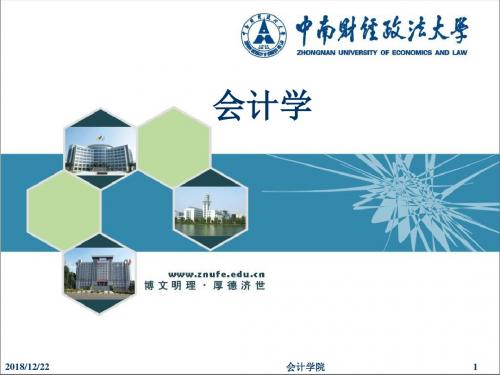
企业会计准则第40号——合营安排
2014年2月17日财会[2014]11号,2014年7月1日施行
企业会计准则第41号——在其他主体中权益的披露
2014年3月14日财会[2014]16号,2014年7月1日施行
2018/12/22 会计学院 37
第五节 会计规范与会计准则
国际财务报告准则
2018/12/22
2018/12/22
会计学院
11
第一节 经济发展与会计演进
朱镕基
设立三所国家会计学院 题词
不做假账(2001.4.16上海国家会计学院) 诚信为本,操守为重,遵循准则,不做假账( 2001.10.29北京国家会计学院)
2018/12/22
会计学院
12
诚信之歌
有一个题词情深意长 有一种精神传承弘扬 同志啊!朋友呀!听我唱一唱 四句话十六字 我们记心上 诚信为本 操守为重 坚持准则 不做假账 地址: /bottom/yuange1120.htm
2018/12/22
会计学院
16
第二节 会计目标
财务会计报告目标层级
2018/12/22
会计学院
17
第二节 会计目标
联合概念框架的通用财务报告目标
财务报告目标定位
是形成概念框架的基础
财务报告的主要使用者
不仅在企业外部,也包括企业内部的管理层,但主要 的使用者是现在的和潜在的投资人、贷款人和其他债 权人
会计学院
3
课程教学内容
第一章 第二章 第三章 第四章 第五章 第六章 第七章 第八章 第九章 第十章
2018/12/22
总论 会计核算系统 流动资产 对外投资 固定资产和无形资产 负债 所有者权益 经营成果的形成与分配 财务报表列报 财务报表分析
第一章总论
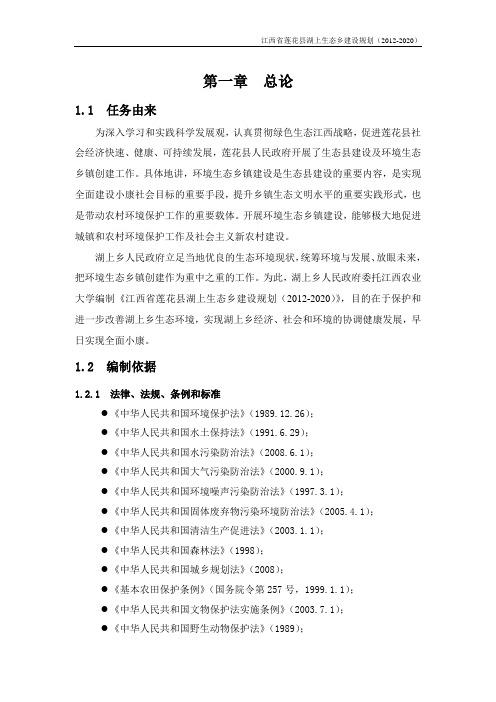
第一章总论1.1 任务由来为深入学习和实践科学发展观,认真贯彻绿色生态江西战略,促进莲花县社会经济快速、健康、可持续发展,莲花县人民政府开展了生态县建设及环境生态乡镇创建工作。
具体地讲,环境生态乡镇建设是生态县建设的重要内容,是实现全面建设小康社会目标的重要手段,提升乡镇生态文明水平的重要实践形式,也是带动农村环境保护工作的重要载体。
开展环境生态乡镇建设,能够极大地促进城镇和农村环境保护工作及社会主义新农村建设。
湖上乡人民政府立足当地优良的生态环境现状,统筹环境与发展、放眼未来,把环境生态乡镇创建作为重中之重的工作。
为此,湖上乡人民政府委托江西农业大学编制《江西省莲花县湖上生态乡建设规划(2012-2020)》,目的在于保护和进一步改善湖上乡生态环境,实现湖上乡经济、社会和环境的协调健康发展,早日实现全面小康。
1.2 编制依据1.2.1 法律、法规、条例和标准●《中华人民共和国环境保护法》(1989.12.26);●《中华人民共和国水土保持法》(1991.6.29);●《中华人民共和国水污染防治法》(2008.6.1);●《中华人民共和国大气污染防治法》(2000.9.1);●《中华人民共和国环境噪声污染防治法》(1997.3.1);●《中华人民共和国固体废弃物污染环境防治法》(2005.4.1);●《中华人民共和国清洁生产促进法》(2003.1.1);●《中华人民共和国森林法》(1998);●《中华人民共和国城乡规划法》(2008);●《基本农田保护条例》(国务院令第257号,1999.1.1);●《中华人民共和国文物保护法实施条例》(2003.7.1);●《中华人民共和国野生动物保护法》(1989);●《中华人民共和国野生植物保护条例》(1997);●《江西省建设项目环境保护条例》(2001.7.1);●《江西省环境污染防治条例》(2009.1.1);●《江西省实施〈中华人民共和国水土保持法〉办法》(1994.4.26);●《风景名胜区条例》(国务院令第474号,2006);●《畜禽养殖污染防治管理办法》(2003.1)。
第一章总论

敏
第一章 总论
第一节 会计的含义
会计的含义即对会计的定义。在 本节中主要介绍我国两种比较有代表 性的观点。 一、会计信息系统论 “会计是为提高企业和各单位的 经济效益,加强经济管理而建立的一 个以提供财务管理信息为主的经济信 息系统。”
二、管理活动论 1.定义
会计是以货币为主要计量单位, 采用一系列专门方法,对社会再 生产过程进行全面、连续、系统 的核算和监督,以提高经济效益 为主要目的的一种经济管理活动。
●会计基本职能的外延:
除以上职能外,会计还具有控制 经济过程、分析经济效果、预测经济前 景、参与经济决策等职能。
(二)会计的反映职能 1. 基本含义
●指会计按照公认会计准则的要求,运用
一定的程序和方法,全面、系统、及时、准 确的表现会计主体的经济业务,为经营管理 提供会计信息。
2. 显著特征度量等为辅助计量单位。
投资者和债 权人等
国家宏观经济管 理部门
会计 信息
企业内部的经 营管理者
其他方面
第六节 会计的方法
一、基本含义 ◆反映、监督会计对象的手段 ◆完成会计任务的手段 二、会计的方法体系(基本内容)P12 ◆会计核算方法 ◆会计分析方法(分析) ◆会计检查方法(审计)
基础方法 研究重点 会计核算 方 法
资金在 销售中 的收回
一定 会计 期间 内的 经营 成果
六、商品流通企业资金运动 及会计要素具体内容 运动状况:三个阶段、两个过程 运动特点及会计要素内容:同工业企业
七、行政、事业单位资金运动及会计要素具体内容 运动状况:两个阶段 要素内容:★资产★负债★净资产★收入 ★支出(预算资金及其收支)
劳动 耗费
劳动 成果
会计活动
- 1、下载文档前请自行甄别文档内容的完整性,平台不提供额外的编辑、内容补充、找答案等附加服务。
- 2、"仅部分预览"的文档,不可在线预览部分如存在完整性等问题,可反馈申请退款(可完整预览的文档不适用该条件!)。
- 3、如文档侵犯您的权益,请联系客服反馈,我们会尽快为您处理(人工客服工作时间:9:00-18:30)。
张华林:《审计学》 第1章 总论 28
第五节 审计准则
一、审计准则问题的提出 1914年,根据“克莱顿法案” 建立了“联 邦贸易委员会”(Federal Trade Committee, 简称FTC)。该委员会提出,有必要就国家主 要行业建立统一的财务会计制度,以规范企业 的会计核算,为建立审计准则提供了前提条件。 会计职业界从会计审计的实际需要出发,试图 通过完善审计程序来实现审计工作的规范化, 进而达到提高审计工作质量和增强财务报表可 信性的目的。
张华林:《审计学》 第1章 总论 17
第二节 审计的产生和发展
二、审计产生和发展的动因
■审计三方面关系人及其关系
财产的委托与受托关系
财产所有者
财产管理者
会计资料及 经济活动
审计者
张华林:《审计学》 第1章 总论 18
第二节 审计的产生和发展
二、审计产生和发展的动因 ■结论 ●受托责任是审计产生的动因 ●审计随着受托责任的发展而发展
张华林:《审计学》 第1章 总论
10
第一节 审计的概念
一、审计的定义
■我国有代表性的定义:审计是由独立的人员对特定经济
实体的可计量的信息及所反映的经济活动,客观地收集 和评价证据,以确定并报告这些信息与既定标准符合程 度的一个系统过程。 ●独立的审计人员 ●特定经济实体的可计量的信息及其所反映的经济活动 ●收集和评价证据 ●与既定标准符合程度 ●系统过程
张华林:《审计学》 第1章 总论 32
第五节 审计准则
四、关于审计准则的争论 (一)反对建立审计准则 剥夺审计人员的判断,妨碍民间审计制度 的健康发展 (二)支持建立审计准则 审计制度要为社会所信赖,就必须建立公 认的审计准则 如果审计界反对建立审计标准,政府就会 介入,职业审计人员失去对未来公认审计准则 建立的发言权
第五节 审计准则
五、审计准则的形式 (二)审计准则的具体形式 ●最初形式:九条准则 一般准则: 检查应由经过充分技术培训并精通业务的人员执 行;对一切与业务有关的问题,审计人员均应保持独 立的状态;在执行业务和编写审计报告时须保持应有 的职业关注。 外勤工作及报告准则: 外勤准则:现场工作应充分计划,若有助理人员, 应予以适当督导;应对现行的内部控制进行适当的研 究和评价,确定对内部控制的依赖程度,并以此作为 拟定审计程序和测试范围的基础;应通过检查、观察、 询问和函证等方法,获取充分而有力的证据,以便对 客户财务报表发表意见提供合理的基础。
张华林:《审计学》 第1章 总论 2
课程介绍与教学要求
■审计学是会计学专业的专业基础课,共 13章,48课时,讲授内容分三部分: ● 其他业务 13章 其他业务 ■课堂教学坚持理论与实务相结合,讲解、 提问和讨论相结合(学习方法)
张华林:《审计学》 第1章 总论
3
课程介绍与教学要求
■ 课程结业成绩中,期末考试成绩占80%, 平时成绩占20%
张华林:《审计学》 第1章 总论
11
第一节 审计的概念
二、审计与查账的区别 ■联系
●审计离不开查帐 ●查帐并不构成审计的全部
■区别
●主体不同 ●内容不同 ●地位不同
张华林:《审计学》 第1章 总论 12
第一节 审计的概念
三、审计与会计的区别
■目的不同 ●会计的目的是产生会计信息 ●审计的目的是鉴证会计信息 ■责任不同 ●会计责任实质上体现为企业管理当局的责任: 建立健全内部控制 保证资产的安全完整 保证会计信息真实合法和可靠 ●审计责任体现为审计人员对审计报告负责: 审计报告的真实性 审计报告的合法性
张华林:《审计学》 第1章 总论 22
第三节 审计分类
二、审计的其他分类 (二)按审计主体与被审计单位关系分类 ●外部审计 ●内部审计 (三)按审计实施时间 ●事前审计 ●事中审计 ●事后审计 ●定期审计和不定期审计
张华林:《审计学》 第1章 总论 23
第三节 审计分类
二、审计的其他分类 (四)按审计执行地点分类 ●就地审计 ●送达审计 (五)按审计动机分类 ●强制审计 ●任意审计
第二节 审计的产生和发展
西周
张华林:《审计学》 第章 总论
15
第二节 审计的产生和发展
隋、唐
张华林:《审计学》 第1章 总论
16
第二节 审计的产生和发展
一、中外审计产生和发展简介
■西方现代审计发展概要 ●CPA审计产生的摇篮--意大利 ●CPA审计的形成地带--英国 英国南海公司破产案 南海 爱丁堡会计师协会的成立 ●CPA审计的发展中心--美国 20世纪初:资产负债表审计--偿债能力 20世纪20年代至40年代:会计报表审计--偿债与 盈利能力(修改) ■内部审计发展概要
■ 两次讨论课 审计准则与审计独立性() 自选审计案例分析(可三至五人合作进行, 第十三周上交PPT,作为平时成绩的一个重要内 容。以上内容二选一。讨论根据情况确定。)
张华林:《审计学》 第1章 总论
4
主要参考资料
■《中国注册会计师执业准则》+ 准则指南 ■《中华人民共和国注册会计师法》 《中华人民共和国 审计法》 ■《会计研究》《审计研究》,中国会计学会、审计学会 ■《中国注册会计师》,CICPA主办 ■《审计学—整合法》(中译本),东北财经大学出版社, 05年版(张龙平主译) ■各年度CPA全国统考--审计试题及答案汇编 ■《审计》--CPA全国统考教材 ■中国注册会计师协会网站 ■国际审计与保证准则委员会网站 International Audit & Assurance Standards Board(IAASB),
张华林:《审计学》 第1章 总论 20
第三节 审计分类
一、审计的基本分类 (二)按内容、目的分类 ●合规性审计:对一个单位某些财务或经营活 动收集并评价证据,以确定其是否按照特定的 标准来执行。 ●绩效审计:也称经营审计或管理审计,是指 检查一个企业或组织经营的程序和方法以确定 其经营效率、效果和经济性。 ●财务报表审计:审查企业编制的一套完整的 财务会计报表,以确定这些可计量的信息是否 符合既定标准的过程。
张华林:《审计学》 第1章 总论 21
第三节 审计分类
二、审计的其他分类 (一)按审计范围分类 ●全部审计:又称全面审计,是指对被审单位 一定期间的全部经济活动及相关的资料进行的 审计。 ●局部审计:又称部分审计,是指对被审单位 一定期间的部分经济活动及相关的资料进行的 审计。 ●专项审计:又称专题审计,是指对某一特定 项目大势已去进行的审计。
张华林:《审计学》 第1章 总论 29
第五节 审计准则
二、民间审计准则的萌芽时期 ——从《统一会计》到《独立 公共会计师对财务报表的检查》 (一) 《统一会计》 1917年,美国会计师协会(简称AIA)发表《统 一会计——联邦储备委员会的暂行建议》(Uniform Accounts: A Tentative Proposal Submitted by the Federal Reserve Board)。1918年将其改名为《编制资 产负债表的公认方法》(Approved Methods for the Preperation of Balance Sheet Statement),标志着资 产负债表的编制和审计开始迈向标准化的道路。
张华林:《审计学》 第1章 总论
19
第三节 审计分类
一、审计的基本分类 (一)按主体分类 ●政府审计:国家审计机关代表国家依法对政 府机构及国有企业进行的审计,包括政府财政 收支审计和国有企业审计。 ●内部审计:各单位自身设置的相对独立的审 计部门对单位内部进行的审计。 ●注册会计师审计:由政府有关部门审核批准 的注册会计师组成的会计师事务所所进行的审 计。
张华林:《审计学》 第1章 总论 24
第四节 审计机构及人员
一、审计机构 (一)政府审计机构 ●立法型模式 ●司法型模式 ●行政型模式 (二)内部审计机构 ●董事会或审计委员会领导 ●最高管理者领导 ●总会计师或主管副总裁领导
张华林:《审计学》 第1章 总论 25
审计署调查驻长沙办豪宅
张华林:《审计学》 第1章 总论
26
第四节 审计机构及人员
一、审计机构 (三)注册会计师审计机构 ●会计师事务所 形式 设立 ●国际会计师事务所 八大 六大 五大 四大
张华林:《审计学》 第1章 总论 27
第四节 审计机构及人员
二、审计人员 (一)审计人员的遴选制度 ●注册会计师考试制度 专业阶段考试:会计、审计、财务成本管 理、经济法、税法、公司战略与风险管理 综合阶段考试:职业能力综合考试
审计关系 审计准则
张华林:《审计学》 第1章 总论
9
第一节 审计的概念 一、审计的定义
■AAA的定义:为对关于经济活动及经济事项的认
定,客观地获取和评价证据,以确定那些认定符 合既定标准的程度,并将结果传达给利害关系人 的一个系统过程。 ●经济活动及经济事项的认定 ●既定标准 ●符合程度 ●将结果传达给利害关系人
张华林:《审计学》 第1章 总论 31
第五节 审计准则
三、审计准则的催产剂——麦克森·罗宾斯(Mckesson & Robbins)公司破产事件..\..\注会培训课件\麦克森•罗 宾斯事件.ppt (一)证券交易委员会 对审计程序做出修改:应收账款函证、存货实地 检查、内部控制制度详细评价、审计人员对公共持股 人负有责任,应加强对管理部门的检查、发表审计意 见 (二)职业界 1939年1月,成立了审计程序委员会并于5月发布 《审计程序的扩展》,对四个方面做出了改善:存货 检查、应收账款检查、委任注册会计师、审计报告。 1941年将其以《审计程序说明书》(Statements on Auditing Procedure)的形式分发给协会会员。
